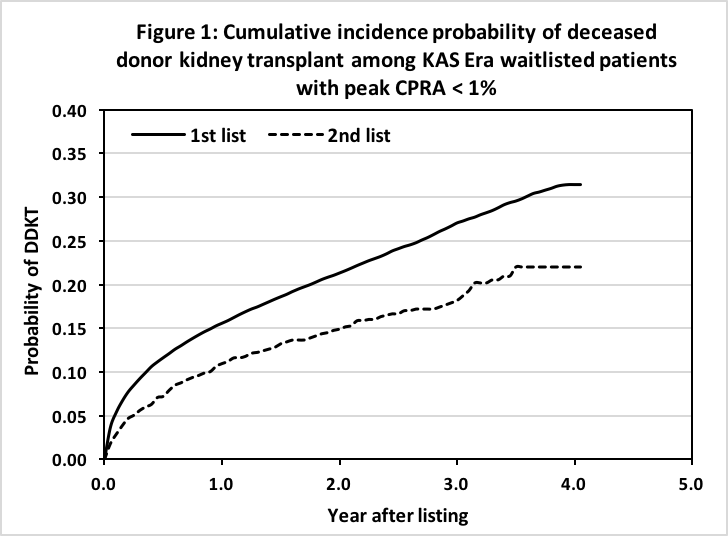When CPRA Zero is Not the Hero: Does KAS Disadvantage Unsensitized Relisted Patients?
Medical University of South Carolina, Charleston, SC
Meeting: 2020 American Transplant Congress
Abstract number: B-012
Keywords: Allocation, Kidney transplantation, Retransplantation, Sensitization
Session Information
Session Name: Poster Session B: Kidney Deceased Donor Allocation
Session Type: Poster Session
Date: Saturday, May 30, 2020
Session Time: 3:15pm-4:00pm
 Presentation Time: 3:30pm-4:00pm
Presentation Time: 3:30pm-4:00pm
Location: Virtual
*Purpose: Since the 2014 Kidney Allocation System (KAS) changes, patients with a very high calculated panel reactive antibody (CPRA) have received greater priority in deceased donor kidney transplant (DDKT) allocation. This change was supposed to be offset by minor declines in allocation to low CPRA patients. However, the CPRA makeup of candidates listed for a 2nd DDKT may substantially differ from those listed for their 1st DDKT. With the high priority given to highly sensitized candidates, we hypothesized that KAS disadvantages unsensitized (CPRA<1%) candidates listed for a 2nd DDKT.
*Methods: This retrospective SRTR database study analyzed adult kidney transplant candidates waitlisted between 10/1/09 and 11/30/18. Subjects were stratified by Pre-KAS v. KAS Era, by 1st v. 2nd listing, and by peak CPRA. The primary outcome was DDKT. We used a competing risk multivariable model to adjust for covariates and competing outcomes that included delisting or death.
*Results: A total of 219,860 waitlist candidates were stratified into 4 cohorts: Pre-KAS 1st listing, Pre-KAS 2nd listing, KAS Era 1st listing, and KAS Era 2nd listing (n= 109694, 10750, 91493, and 7923 respectively). In the Pre-KAS period, unsensitized candidates had similar DDKT rates of 21.2% and 22.4% for 1st and 2nd listing respectively. However in the KAS Era, unsensitized candidates saw the DDKT rate drop by nearly half from 1st to 2nd listing (20.0% v. 12.8%, p<.001, Table 1). Our multivariate competing risk model of unsensitized KAS Era candidates showed that 2nd listing was strongly associated with fewer DDKT (H.R. 0.60, 95% C.I. 0.53-0.68, p<0.0001, Fig. 1). Meanwhile, highly sensitized KAS Era candidates (CPRA 98-100%) had the highest DDKT rates of 36.0% and 30.7% for 1st and 2nd listing respectively (Table 1).
*Conclusions: Since the 2014 KAS changes, the DDKT rate significantly fell in unsensitized 2nd listing candidates. This new inequity in DDKT access may be the result of overprioritizing highly sensitized candidates in a subpopulation with a shift towards higher CPRA values. Further research and predictive modeling by the OPTN/UNOS to determine the impact of point allocation changes should be explored.
To cite this abstract in AMA style:
Casey M, Su Z, Ahmed MMohamed, Taber D, Weeda E, Morinelli T, Mauldin P, Soliman K, Posadas-Salas MA, Rao V, DuBay D. When CPRA Zero is Not the Hero: Does KAS Disadvantage Unsensitized Relisted Patients? [abstract]. Am J Transplant. 2020; 20 (suppl 3). https://atcmeetingabstracts.com/abstract/when-cpra-zero-is-not-the-hero-does-kas-disadvantage-unsensitized-relisted-patients/. Accessed December 24, 2025.« Back to 2020 American Transplant Congress


